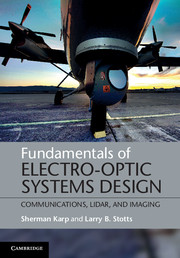Book contents
- Frontmatter
- Contents
- Preface
- Notation
- 1 Genesis of electro-optic systems
- 2 Role of electromagnetic theory in electro-optics systems
- 3 Photo-detection of electromagnetic radiation
- 4 Metrics for evaluating photo-detected radiation
- 5 Contrast, visibility and imaging
- 6 Signal modulation schemes in optical communications
- 7 Forward error correction coding
- 8 Modern communications designs for FOC/FSOC applications
- 9 Light detection and ranging
- 10 Communications in the turbulence channel
- 11 Communications in the optical scatter channel
- Appendix A Two-dimensional Poisson processes
- Appendix B Propagation of finite beams in water
- Appendix C Non-Lambertian scattering
- Appendix D Communications noise sources besides signal/background shot noise
- Index
- References
9 - Light detection and ranging
Published online by Cambridge University Press: 05 February 2013
- Frontmatter
- Contents
- Preface
- Notation
- 1 Genesis of electro-optic systems
- 2 Role of electromagnetic theory in electro-optics systems
- 3 Photo-detection of electromagnetic radiation
- 4 Metrics for evaluating photo-detected radiation
- 5 Contrast, visibility and imaging
- 6 Signal modulation schemes in optical communications
- 7 Forward error correction coding
- 8 Modern communications designs for FOC/FSOC applications
- 9 Light detection and ranging
- 10 Communications in the turbulence channel
- 11 Communications in the optical scatter channel
- Appendix A Two-dimensional Poisson processes
- Appendix B Propagation of finite beams in water
- Appendix C Non-Lambertian scattering
- Appendix D Communications noise sources besides signal/background shot noise
- Index
- References
Summary
Lidar (light detection and ranging) is an optical remote sensing technology that measures properties of scattered and reflected light to find range and/or other information about a distant target. The common method to determine distance to an object or surface is to use laser pulses, although as in radar it is possible to use more complex forms of modulation. Also as in radar technology, which uses radio waves instead of light, the range to an object is determined by measuring the two-way time delay between transmission of a pulse and detection of the reflected signal. In the military, the acronym Ladar (laser detection and ranging) is often used. Lidar has also expanded its utility to the detection of constituents of the atmosphere. It is not the intention of this book to expand on all the applications for which this technology has been applied, they are too numerous. Rather we will try to group applications by the technology needed. Thus, for example, a laser speed gun used for traffic monitoring uses the same basic technology as those used for surveying and mapping; i.e., bursts of nanosecond pulses. The wavelengths may vary due to eye safety requirements (>1.5 μm), and the pulse energies may vary because of the distances involved, but both use time of flight measurements. Also the scanning requirements can vary because of the areas to be covered, and the scanning equipment that is available can vary because of the pulse energies involved. For high-energy pulses reflective mirrors are needed, whereas for low-energy pulses electronic scanning with a CCD or CMOS shutter can be used. Most applications use incoherent optics. In some cases, where the additional cost warrants it, coherent (optical heterodyne) detection is used. Such an example is the measurement of clear air turbulence where coherent 10 μm laser ranging systems have been employed. Another class of incoherent applications use backscatter signatures to investigate chemical constituents, primarily in the atmosphere. Such systems use Raman, Brillouin, Rayleigh, and Mie scattering, as well as various types of fluorescence. As we discussed in Chapter 5, Mie theory covers most particulate scattering, ranging from the Rayleigh range ~1/λ4 for smaller particles (molecules) to the larger particles (aerosols). Raman and Brillouin scattering both induce wavelength shifts, requiring multiple wavelength generation and discrimination. The selection of interference filters, prisms, gratings or spectrascopic machines is determined by the resolution and costs associated with the specific application.
- Type
- Chapter
- Information
- Fundamentals of Electro-Optic Systems DesignCommunications, Lidar, and Imaging, pp. 151 - 178Publisher: Cambridge University PressPrint publication year: 2012



